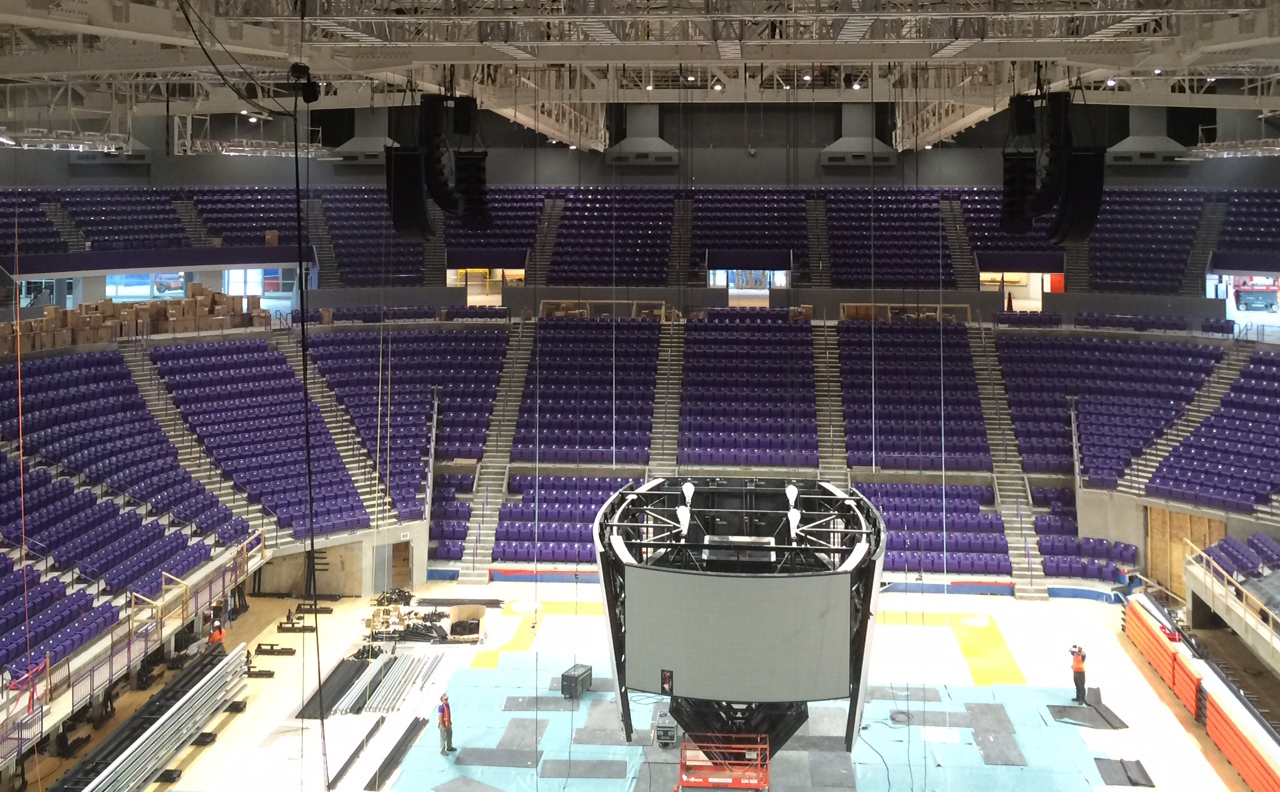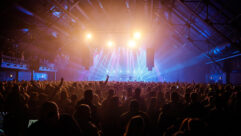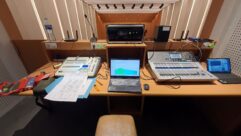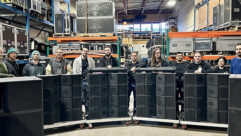On this edition of the SVC Podcast, Contributing Editor Bennett Liles talks with Jim Brawley of James S. Brawley and Associates in Clemson, South Carolina about the 55-million-dollar renovation of Clemson University’s Littlejohn Coliseum. Brawly served as the audio consultant on the project that included speaker arrays, routing systems and audio control for the basketball arena and many other areas of the complex. In Part 1, Jim outlines the selection and installation of Bose RoomMatch speaker arrays.
Links of Interest:
· James S. Brawley and Associates audio consulting
· Stage Front Presentation Systems, installers on the project
· Bose RoomMatch speaker arrays used in the Littlejohn Coliseum
· Midas M32 digital mixing console used in Clemson sports venues
· Clear-Com SB-704 4-channel communication system
This is the SVC Podcast from Sound & Video Contractor with Jim Brawley of James S. Brawley and Associates. We’ve got the show notes and product links for all of the podcasts at svconline.com. Go to Podcasts at the top of the page.
At Clemson University they’re serious about sports and when their Littlejohn Coliseum got a $55 million renovation they needed mics, playback and announcer sound everywhere. For the main coliseum court, outside areas, clubs and practice courts they brought in Jim Brawley to get it all working. He’s here today to tell us how he just that, coming up on the SVC Podcast.
Jim Brawley, nice having you with us coming from Clemson, South Carolina. You were the go-to guy for sound in a mighty big renovation of Clemson’s Littlejohn Coliseum. They must have had a good reason for calling you in on such a huge project so tell us about James S. Brawley and Associates and the projects you handle there.
I started my consulting practice in 1983. I’ve worked on many types of projects for the architectural and engineering community and systems contractors and loudspeaker manufacturers. But mostly my business now is in sound systems for entertainment and sports and worship. So the types of projects I do are usually large venues that require complex loudspeaker systems and then all the audio that goes with it to make it work. [Timestamp: 1:30]
Well that was certainly the case here. Littlejohn Coliseum is huge, with over ten thousand seats and more than 150 events a year in sports, concerts, graduation ceremonies, trade shows and a whole host of other things. The people at Clemson are pretty rabid about their sports and not just football.
That’s true. The football team has been very successful, and the baseball team and basketball teams are on the rise. I’ve done work for football and baseball and soccer, and currently have a new facility that is the tennis center that they’re building over there. I went to Clemson University and happen to live in Clemson, and it’s only been in the last two years that I’ve actually got connected to the athletic department over there to be their consultant for their sound system and their venues. [Timestamp: 2:16]
And so you were contracted as the audio consultant on this, I believe, by architectural design firm LS3P and where are they, in Greenville?
They’re all over Georgia and the Carolinas, but this project is from the Greenville office. I got connected to the Clemson athletics through the company that does their audio production for their athletic events. That’s Custom Audio and Lighting in Abbeville, South Carolina. They have guys onsite all the time taking care of venues and they do their game day operations. When a project came up over at the Memorial Football Stadium, they recommended that I take on the large part of the extensive loudspeaker distribution work. So they got LS3P to hire me for that venue and since then the athletic department has gotten LS3P and other architects to hire me for their other venues as well. So I really appreciate that opportunity to do all that work for them. They’re not my only client, but they’re the closest one. It’s a miracle that you get a project that’s five minutes from your house. That can be good and bad. [Laughs] You’re real close, but also you’re real close. [Timestamp: 3:26]

Right and we rarely get to talk about one that might have actually been a little too close. This one involved much more than just the basketball court itself but a lot of other far-flung areas as well. You selected the Bose RoomMatch system for Littlejohn Coliseum and I’d be interested to know what took you to that one. Had you heard that Bose system in action before?
I was familiar with their system and had used them in much smaller venues before, and I know that in Greenville, South Carolina at the Bon Secours Wellness Arena, which is the hockey arena over there, they did an upgrade with Bose RoomMatch. And while the Littlejohn Coliseum was being renovated, Clemson basketball played their games over there. So I went to a couple of games over there to see how that system performed and whether it was meeting their game day production needs, and it certainly was. It worked quite well. We didn’t hesitate to accept Bose RoomMatch as one of the many alternate loudspeaker systems that we had specification documents for. [Timestamp: 4:25]
That was a great opportunity in being able to hear it not just in a demo but in actual use in a live venue similar to the one you were auditioning it for.
Yeah. What was important to me was to understand how the Clemson game day marketing people would utilize the sound system and what they needed to run through it, how loud they wanted it to go. All of those types of things really made what we needed to do at their new basketball arena a success. [Timestamp: 4:51]

And I think you used something like 36 RoomMatch array modules. Were these the DeltaQ modules or some of the earlier Bose gear?
These were the first RoomMatch modules. Bose has two DeltaQ arrays. One is called ShowMatch, which is a small dual eight-inch system configured for portable use. And then their fixed installed system, which is the first one they came out with called RoomMatch, is a dual 10-inch system. It’s a much larger enclosure and more variety in the horn patterns that you can select for fixed installs. This system is now two seasons old so at the time they didn’t have the ShowMatch, but the RoomMatch met the criteria very well. RoomMatch works using a model of the speaker arrays and their Bose Modeler design software that helps you select the right patterns of each box. Each RoomMatch box can have an individual horn pattern that can be configured to match the seating planes specifically. So you just don’t have one or two polar patterns out of their boxes. You have a wide variety of them. There’s close to 30 different patterns that you can pick in each module to optimize your coverage area. One of the challenges we had was we had to hang the loudspeakers in specific places that will allow future service by chain motor use because the reconfiguration of the basketball arena would prevent at 80-foot lift form making its way onto the court to service anything that was that high in the air. So we picked specific positions there that we could put a break in the rigging that would allow you to install a chain motor to lift the array up and disconnect it and lower it to the ground for service. Which may happen at some time in the future, but we’ve had no service issues up to this point. [Timestamp: 6:39]
And when you got to the point of actually rigging the arrays was there anything special or out of the ordinary on the rigging job?
Well, the only thing that was out of the ordinary is we had specific locations. They were putting in a concert grid so the concert people could walk on a grid and power up their chain motors for lifting up concert systems. So we had to be sure we weren’t in the way of that. We had to be close to the catwalk so that riggers could put in chain motors for lifting the Bose arrays and taking them down if they needed to. So the challenge was to design the loudspeaker arrays so that they could go at these specific locations to allow ease of installation and future service. The other thing that was an advantage for the RoomMatch is that they already had a sound system in there before that was removed. But if we used the RoomMatch we could reuse the trunk loudspeaker wire cabling from the amp rack location to the catwalk area without having to pull any additional wires. So that was a big cost savings advantage we were able to put together. So part of the design was to make use of that existing wiring without having to replace it. [Timestamp: 7:48]
And at the other end of the cables the PowerMatch PM8500N power amps. Where did you locate those?
The older system had an existing AV loft where all of the game production was and they wanted to reutilize that loft in the same way. One thing that’s different about the Coliseum renovations, they rotated the court 90 degrees from where it was so that loft was on the side court before and it’s on the end court now. But that same loft is holding all of the Daktronics scoreboard racks. We repurposed two existing sound system racks. We stripped the gear out, but the rack locations and the conduit was already there so we could just reutilize those two locations. So we put a third rack location at court level in a storeroom. That gave us ability to easily connect the I/O cables to the court level at that particular rack position. [Timestamp: 8:43]
How did all of this fit into the bigger schedule? They obviously would have a certain amount of work that had to go on first and then get your guys in there and maybe then even get your guys out of the way for something that came in later.
We had probably eight months from contract to use and we had to do some tough scheduling because we had to get loudspeakers suspended before they closed the tunnel that would allow you to have a lift in there. And also they wanted the loudspeakers suspended before they had to put the court down. We had three phases of work. We had suspending the bowl arena loudspeaker systems then installing the other systems, which included an extensive concourse system and a large gathering space gallery system and several club systems and the practice court. We had to do all that while we were waiting for completion in parts of the Coliseum arena itself. And then the third phase was connecting all of the bowl system amplifiers and verifying their performance. [Timestamp: 9:46]

The other parts of this we’re going to be covering in Part 2 but in addition to the speaker system there’s a four-channel Clear-Com intercom system and a Midas M32 digital mixer.
Yeah. They were using the Clear-Com system, but during the construction of the project the athletic department wanted to supplement that with a wireless system. So in addition to the four hardwired Clear-Com channels there’s also a Clear-Com FreeSpeak system that will connect to that four channel system to give them wireless intercom capabilities for their game day production. So that system is in there, and then we’ve been using Midas M32 consoles at football and baseball so we used the same M32 console at basketball. So all three major sports venues have the same console. The console was selected by the game day operators, Custom Audio and Lighting. So we incorporated what they needed into the design of these systems. Then in Littlejohn Coliseum, the Midas console connects to a stage box at the court level rack and all of the court level audio cables go to that stage box. And it’s connected with fiber optic to the mixing console. There’s probably 500 feet of cable distance. We needed to use fiber for that. [Timestamp: 11:01]
And with the fiber, no grounding problems or ground hum or anything like that.
No, it all works really well. We do have some analog audio tie lines. I always stick those in just in case. [Timestamp: 11:11]
Always a good idea to still have a few XLRs in there somewhere.
Most of the stuff is connected through the Midas fiber system. We also have to provide feeds for broadcast people, so a lot of that is analog audio cable as well. [Timestamp: 11:26]
Lots of broadcasts coming out of there I’m sure that you have to interface with.
I’d like to also mention that we got good support from Tom Tyson and Jeff Lange at Bose. They both came to the site at particular times to help out with programming and commissioning of the system. [Timestamp: 11:42]
Always such a great thing to have solid onsite support from the manufacturer to assist with any problems or answer any questions. In Part 2 we’ll go into more detail on it but it’s been fun finding out how you got in here and got the speaker arrays up and running. We’ve been talking to Jim Brawley of James S. Brawley and Associates in Clemson, South Carolina about the $55 million renovation of Clemson University’s Littlejohn Coliseum. Look forward to hearing about the other areas of this project.
All right. Thanks, Bennett.
So Clemson’s Littlejohn Coliseum got everything in place and working as advertised. Next week Jim is going to take us to the outside decks, the practice courts and the clubs to see how their sound was set up to make game days a total sound experience. Be with us for the rest of the story next week on the SVC Podcast.










